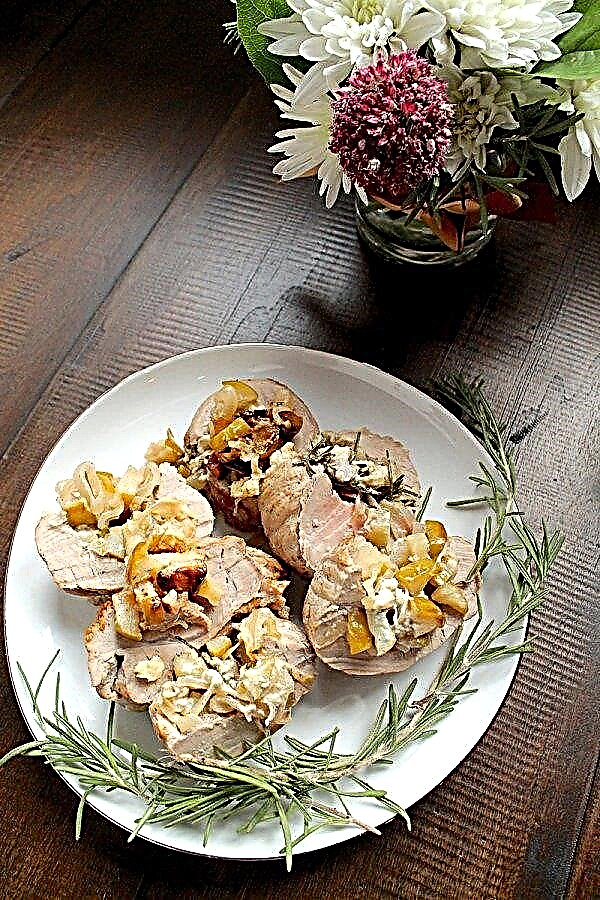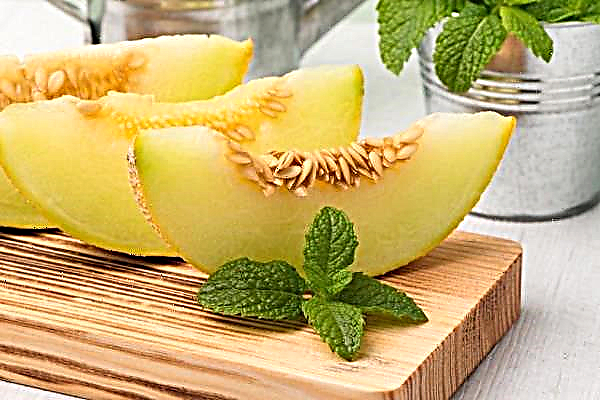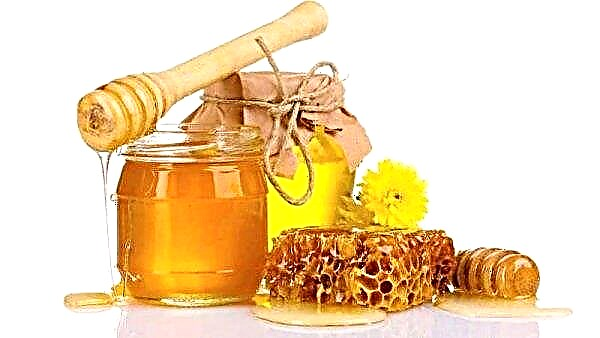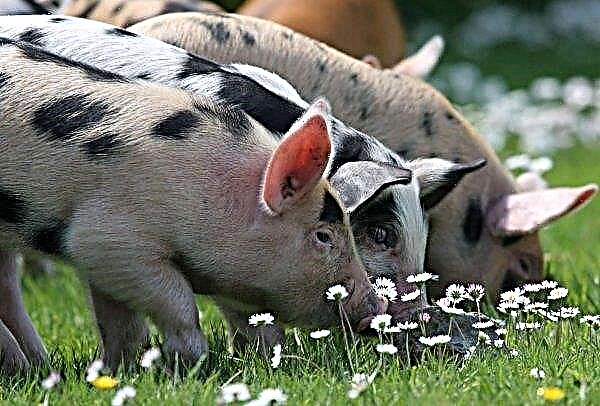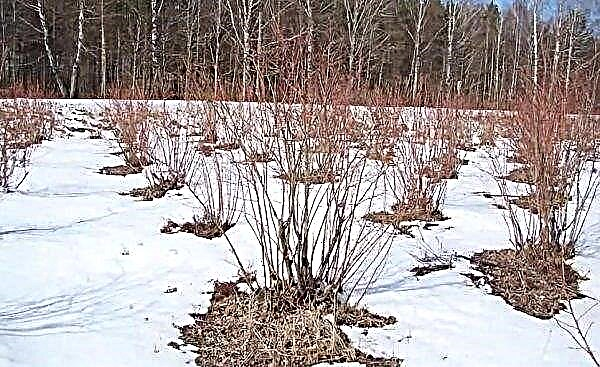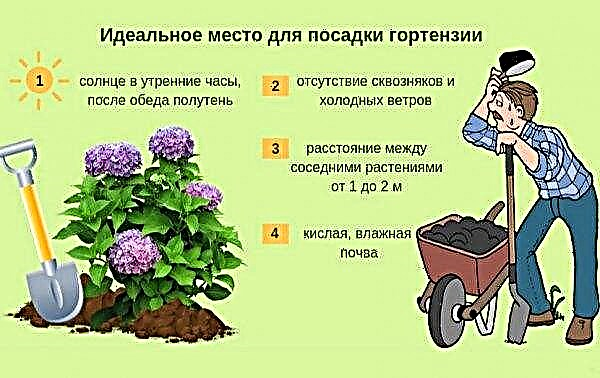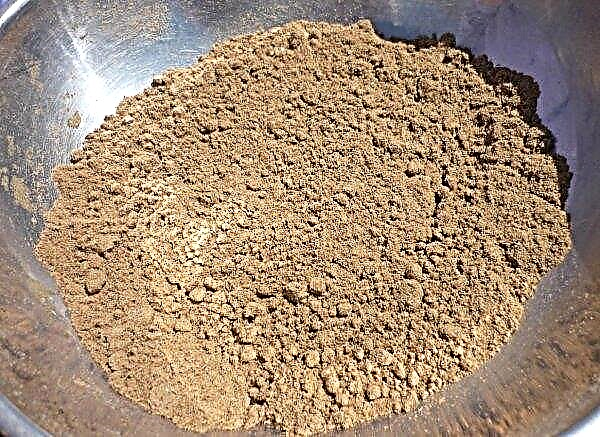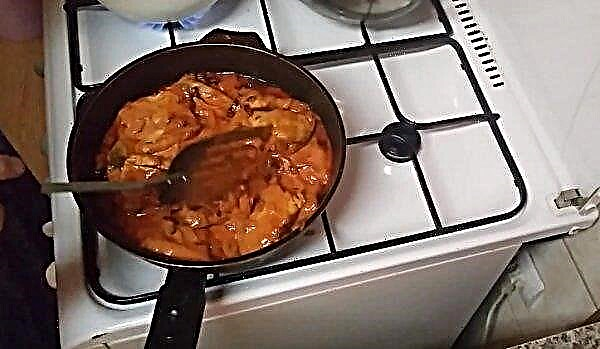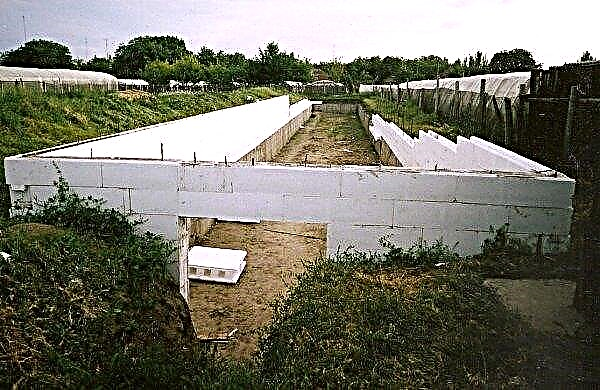Pepper California Miracle is a popular cultivar cultivar. The rules of agricultural technology outlined in this article will allow each gardener to get an excellent harvest of tasty and healthy vegetables.
Grade description
California Miracle belongs to the sweet varieties of bell pepper and has long been known in our region. The variety has characteristics that allow you to compete with modern hybrids.
Did you know? In South America, a variety of pepper called Bellflower has been developed, the shape of which looks more like a flower bud. In addition, this exotic vegetable combined the tastes of sweet and hot peppers in one fruit (the tip is sharp, it becomes sweeter down).
Distinctive features of the variety:
- mid-ripeness with a vegetation period of 115–120 days before technical ripeness, for saturated coloring it will take about two more weeks;
- powerful bush up to 80 cm high with thick stems and large leaves;
- fruits of a cuboid shape with a characteristic ribbing;
- the weight of one pepper is from 90 to 140 g, the wall thickness after full coloring is up to 10 mm;
- the skin is shiny and smooth, red.

Fruit quality and yield:
- peppers have a sweet taste with a characteristic aroma and smell;
- sugar content is one of the highest;
- the variety has excellent safety and transportability;
- fruits are used fresh and for heat treatment, including for stuffing and preservation;
- 7-10 fruits are removed from one bush.
Advantages and disadvantages
- The advantages of the California miracle are:
- high productivity;
- excellent taste and marketability of the fruit;
- resistance to the mosaic virus;
- universal growing conditions.
- The disadvantages of the variety include:
- extra time for coloring fruits;
- instability to late blight.
How to grow seedlings at home?
The variety is grown according to traditional technology through sowing seeds for seedlings. You can use both purchased and self-collected seeds. The fruit from which the seed material is collected is selected to be fully ripe and removed from the best bush.
Did you know? Sweet pepper takes the second place in the content of vitamin C, overtaking citrus fruits, black currants and other source plants of this vitamin.
Sowing time
In open ground seedlings are planted at the age of three months. In this regard, the seeds are planted in late February. Earlier sowing is possible under the condition of additional artificial illumination of plants, which will ensure the necessary duration of daylight hours.
The soil
For growing seedlings, you can purchase soil in a store or garden center. If there is access to turf land, you can prepare the soil mixture yourself.
The following proportions are suitable:
- 2 parts of turf land;
- 1 part of fine sand and peat.
Soddy soil is disinfected by watering with a solution of potassium permanganate, or one of the following methods:
- steaming for 7-8 minutes;
- calcination in the oven for 30 minutes (at +70 ... + 90 ° C);
- soil freezing and thawing (at –15 ° С, repeat up to three times).

Capacity
The assortment of stores presents plastic and peat containers for seedlings. For sowing without picking, individual glasses are suitable, and if plant transplantation is planned, use a common shallow container for the first stage. It is necessary to prepare a cover or film to provide an analogue of the greenhouse conditions after sowing.
Seed preparation
Pepper seeds have a good germination capacity, but to ensure the best result, it is recommended to carry out a number of additional treatments.
Important! The best germination ability of seeds age 1–2 years, then it’s better to collect new material.
Having manually selected the largest seeds, they are subjected to the following procedures:
- placed in saline solution (3 g of salt per 1 liter of water) and “drowned” specimens are taken;
- etched with a weak solution of potassium permanganate for 15-20 minutes;
- growth stimulant treatment (according to instructions).

Sowing seeds
Seeds are planted to a depth of 1 cm, sprinkled with earth and watered with warm water from a sprayer. Since pepper does not respond well to transplanting, seeds are planted in individual containers or leaving large gaps between future sprouts. In this case, it will not be difficult to “pass” sprouts with an earthen lump. The sowing container is closed with glass or film and cleaned in a warm place (+26 ... + 28 ° C).
Seedling Care
When the seedlings appeared, the shelter is removed and the plants rearranged in a bright place, if necessary, adding light to the planting lamps. The temperature must be maintained at a level of +20 ... + 25 ° C. Watering the seedlings is carried out as the top layer of the soil dries, using well-maintained warm water. If the plants are planted in a common container, the transplant is carried out after the appearance of two true leaves. Possessing a weak root system, pepper seedlings after transplantation slow down growth and recover for a long time.
Important! Pepper seedlings needed 12-hour light day!
Therefore, the container must be watered the day before so that the earth has an optimal density and does not damage the roots. The plant is carefully removed with a lump of earth and transplanted without deepening the growth point. Unlike tomatoes, you can’t trim the central root when transplanting pepper! If the soil mixture is properly prepared and the plants look healthy, fertilizing is not required. In other cases, the first fertilizer is produced with nitrogen-potassium mixtures 7 days after the first transplant. The second top dressing with an increased content of phosphorus and minerals is introduced 4 days before the planned planting in open ground.
If the soil mixture is properly prepared and the plants look healthy, fertilizing is not required. In other cases, the first fertilizer is produced with nitrogen-potassium mixtures 7 days after the first transplant. The second top dressing with an increased content of phosphorus and minerals is introduced 4 days before the planned planting in open ground.
Seedling hardening
Ten days before transplanting, seedlings begin to harden: they are taken out into the open air, gradually increasing the time of the “walk”. In recent days, peppers should spend outdoors full daylight hours. The air temperature should not fall below + 13 ° C. For hardening, choose a place that is not blown by drafts and does not burn in direct sunlight.
When and how to transplant seedlings to a permanent place?
Peppers are transplanted into the open ground after the threat of freezing disappears, which occurs in late May - early June. In the greenhouse, you can plant seedlings before. For planting, select a site in a sunny, windless place. The best precursor plants for this crop will be cabbage, legumes, onions and cucumbers. Planting after solanaceous plants should be avoided and pepper should not be planted on the same bed again. For the transplantation, a cloudy day is chosen when the temperature on the soil is + 15 ° C. Plants are planted at intervals of 40 cm in the soil, previously spilled (in 5 days) with a weak solution of copper sulfate (1 teaspoon in a bucket of water). As with the first transplant, the plants are planted to the same depth and the stem is not buried. After planting, pour seedlings with warm water.
For the transplantation, a cloudy day is chosen when the temperature on the soil is + 15 ° C. Plants are planted at intervals of 40 cm in the soil, previously spilled (in 5 days) with a weak solution of copper sulfate (1 teaspoon in a bucket of water). As with the first transplant, the plants are planted to the same depth and the stem is not buried. After planting, pour seedlings with warm water.
Important! Pepper is characterized by cross-pollination, so sweet and bitter varieties should be planted at the maximum distance from each other.
How to care in the open ground?
Caring for the California miracle is not difficult and includes agronomic techniques that are characteristic of other varieties of pepper.
Watering
Perform under the root with exclusively warm water. Cold water can cause slow growth and low yields. Depending on the weather and the presence of mulch, watering may be required from one to two times a week.
Fertilizer application
Three times a season, plants are fertilized with infusions of humus, manure or complex mineral mixtures (under the root). The first top dressing is introduced 14 days after planting, then during flowering and in the stage of fruit loading.
When the ovaries and flowers fall, they are sprayed with a solution of boric acid (1 teaspoon per 10 liters of water), and if the fruits are formed slowly - with a solution of superphosphate (1 teaspoon per 5 liters of water).
Tillage
Peppers need loose soil without weeds. It is easier to achieve this result using mulching. During planting, the ground under the bush is covered with hay, dried grass, a mixture of sawdust.
Such a shelter allows you to solve several problems:
- protects the soil from drying out and overheating;
- preserves soil friability;
- limits weed growth;
- protects fruits from pollution and high humidity.

Stitching and tying bushes
In order for the bush to branch well, they carry out stepsoning and molding. When the plant reaches 30 cm, remove the top bud. Weak pinions of the second row pinch, leaving 2 strong stems. On the resulting lateral shoots, only a strong branch is left, cutting off the rest under the first leaf. It is believed that the variety does not need to be tied up, however, it is worth approaching this recommendation individually and it is better to tie bushes with a large number of fruits.
Harvesting
To prolong fruiting, peppers are removed in the stage of technical ripeness, leaving to ripen and fill with color in the room. Cut fruit better with a pruner or knife, so as not to damage the plant. The leg is left on pepper, this increases the shelf life.
The fruits of the California Miracle are stored in a cellar or refrigerator. At a temperature of about + 2 ° C in a dark place, ripe pepper can be stored for up to six months, and at a higher temperature - up to two months. In general (peeled from seeds) or chopped, the vegetable is suitable for deep freezing. The variety is suitable for all dishes with sweet pepper, for example:
The variety is suitable for all dishes with sweet pepper, for example:
- fresh salads and snacks;
- stuffed peppers;
- vegetable soups and stews;
- preservation and pickling.
Sweet pepper California miracle has earned many positive reviews from gardeners from different regions, which note the high taste and simple care of this plant. Despite the long history, the variety does not lose ground before new hybrids in the conditions of a personal plot.

